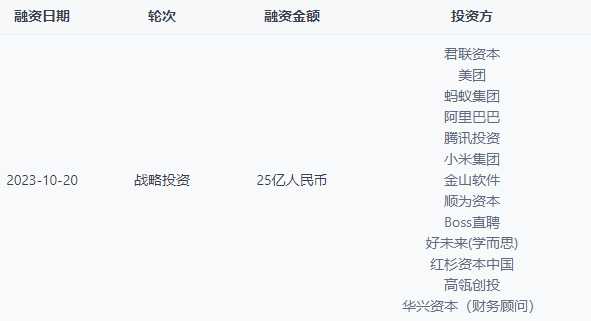Article Source: 36Kr
In the current narrative context of large models, Zhipu AI needs to get used to standing in the spotlight.

Image Source: Generated by Wujie AI
01 Zhipu AI, Standing in the Spotlight
Over 2.5 billion RMB, this is the total financing amount accumulated by Beijing Zhipu Huazhang Technology Co., Ltd. (referred to as Zhipu AI) this year, making it one of the highest publicly financed large model startups in China.
After the release of ChatGPT, the technological craze sparked by large models quickly turned into an investment craze. However, unlike in the past, it is widely recognized that this is a race track with an even stronger Matthew effect, affecting both investors and startup companies.
On the one hand, at the current stage, large model startups heavily rely on heavy resources and strong capital, and the number of startups capable of entering the field is already limited, reducing the options for investors.
On the other hand, most people believe that large models are comparable to or even surpass the opportunities presented by the internet, leading to soaring valuations for companies. Well-known investors and institutions are also "group buying" into these opportunities.
According to 36Kr's understanding, the financing amount officially announced by Zhipu AI is still a conservative estimate, and there are still ongoing financing discussions.
From 2019 to 2023, Zhipu AI has raised a total of over 3 billion RMB in three rounds of financing. And this year, both the frequency and amount of financing have far exceeded previous levels.
In 2019, Zhipu AI was officially established, with Pre-A round investors including Zhongke Chuangxing, Tsinghua Holdings, etc., A round investors including Dachen Cai Zhi, Huakong Fund, etc., and B round investors including Junlian Capital, Qiming Venture Partners, etc.
According to the information released by Zhipu AI, the main investment participants include the Social Security Fund Zhongguancun Independent Innovation Fund (Junlian Capital is the fund manager), Meituan, Ant Group, Alibaba, Tencent, Xiaomi, Kingsoft, Shunwei, Boss Zhipin, TAL Education, Sequoia Capital, Hillhouse, and many other institutions, as well as some existing shareholders including Junlian Capital.

Image Source: IT Orange
As a star large model startup, Zhipu AI boasts an enviable list of investors. Zhipu AI is not lacking in sources of funding, and its investors are all well-known, with many investors expressing that "now it is definitely Zhipu choosing the investors, rather than the other way around."
Currently, there are many large model startups that have received substantial financing in the industry, and the market is not lacking in funds for large models. However, whether to take the funds and how to do so are the key considerations for large model startups.
Analyzing Zhipu AI's list of investors reveals that funding is not the only consideration; the value represented by the funding can provide different resources to large model startups.
For example, the Social Security Fund Zhongguancun Independent Innovation Fund. At the major technology achievements session of the 2023 Zhongguancun Forum held at the end of May this year, the Social Security Fund announced the establishment of the "Social Security Fund Zhongguancun Independent Innovation Special Fund," with the status of a "national team," a first-phase scale of 5 billion RMB, and a fund term of over 10 years, demonstrating long-term funding characteristics.
Similarly, internet giants such as Meituan, Ant Group, Alibaba, and Tencent not only bring substantial funds but also imply potential industrial cooperation. Many internet businesses have the potential for transformation based on large models, and Zhipu AI's foundational large models can access vast amounts of data and business scenarios, which are lacking for many startups.
In the current narrative context of large models, Zhipu AI needs to get used to standing in the spotlight, which is not quite in line with Zhipu AI's low-key style.
02 The Smoke of Large Models Has Long Been Rising
The emergence of ChatGPT marked a turning point for AIGC, and it can clearly divide the timeline into two stages. Some large companies or startups had already conducted technical research or established new companies focusing on large models when the potential of large models first emerged, while a considerable proportion of companies only made the decision to pursue large models after the release of ChatGPT.
This has led to differences in perception and will also result in different outcomes.
It is widely believed in the industry that 2023 is the first year of large models, but in the eyes of Zhipu AI CEO Zhang Peng, the "first year of AI large language models" should be 2020, the second year after the establishment of Zhipu AI.

Zhipu AI CEO Zhang Peng
In 2017, the Transformer was born, leading to a series of large-scale Transformer models such as GPT-1 and GPT-2, which possessed a large number of parameters and strong generalization capabilities, solving many problems that were previously unsolvable.
It wasn't until 2020 that the emergence of GPT-3 brought generative AI into a new era.
In 2020, Zhipu AI made the decision to fully focus on large model research and development. At that time, due to the high training costs and complex R&D thresholds, large models were not well-regarded by the industry, and Zhipu's development did not attract as much attention as it does now.
However, after the release of ChatGPT, Zhang Peng expressed that he felt "both excited and under some pressure." He was excited because the direction became more certain, but felt pressure due to the urgency of catching up with new technologies.
At the same time, an increasing number of investors turned to Zhipu AI, and the smoke of large models had long been rising. Investors hoped to find someone who could pay attention to the fireworks first.
After a series of investigations, a stable founding team, sufficient technological accumulation, and exploration in commercialization, among other factors, have propelled Zhipu AI from obscurity to stardom.
In terms of the founding team, Zhipu AI was incubated by Tsinghua KEG (Knowledge Engineering Laboratory), and this team emerged from the laboratory to enter the market, leading to the formal establishment of Zhipu AI.
CEO Zhang Peng graduated from the Department of Computer Science at Tsinghua University, and his research direction for his doctoral degree at Tsinghua University was knowledge graph.
Chairman Liu Debing studied under Academician Gao Wen and previously served as the Deputy Director of the Science and Technology Big Data Research Center at Tsinghua Data Science Research Institute. President Wang Shaolan holds a Ph.D. in innovation leadership from Tsinghua University, showcasing the strong ties to Tsinghua University.
In Silicon Valley and even in the global academic community, Zhipu AI has long been well-known. In the eyes of investors, during its time at Tsinghua, Zhipu AI already had "people, technology, and customers," equivalent to a small and beautiful startup company. Moreover, the main personnel had already cooperated for some time, making Zhipu AI naturally favored according to the logic of investing in people and the race track.
Technology is also a strong suit for Zhipu AI. Tracing back to Zhipu's early research, from the "Scientific Research Information Mining" AMiner in 2006, to the company's establishment in 2019, and then focusing on large model algorithm research in 2020, releasing GLM-10B in 2021, GLM-130B in 2022, and the ChatGLM-6B and billion-scale dialogue model ChatGLM in March 2023.
It is reported that Zhipu AI will also release a brand-new generation of large models on October 27. In this fiercely competitive October for the large model industry, whether Zhipu can secure a place remains to be seen, and it will depend on the performance of the new generation of models.
Zhipu AI's research predates that of the vast majority of domestic large model participants, and Zhipu has indeed turned its first-mover advantage into a winning position.
In the world's leading large model evaluation released by Stanford, GLM-130B is the only model selected from Asia, with accuracy and malignancy on par with GPT-3, and showing excellent robustness and calibration error among all models.
ChatGLM-6B was open-sourced on March 14, 2023, and within a few months, it gained 48,000+ stars and 6,800+ forks on GitHub, with over 8,000,000 downloads on Hugging Face, ranking first in the weekly trend. Hundreds of projects have been developed based on ChatGLM-6B, such as LoRA, P-Tuning, langchain, etc. It achieved first place in third-party evaluations for Chinese natural language, Chinese dialogue, Chinese question answering, and reasoning tasks.
03 The Endless Marathon
As a revolutionary general technology, artificial intelligence not only determines the competition between individuals and enterprises, but also concerns national competition. Zhipu's background determines that it is not just a company, but also a team of scholars with technological idealism.
Unlike most companies and institutions, Zhipu AI is charting its own course.
According to 36Kr, the large model research of many domestic tech giants is based on GPT, BERT, and T5. It is understandable for commercial companies, but from a national perspective, China must have its own pre-training framework, not following, but charting its own path. GLM (General Language Model) is Zhipu's answer.
Developing proprietary large models is not easy and involves extremely high risks. "The impact of GPT-3 on us was to firmly decide to develop a dense, billion-scale, bilingual model. Because after our research that year, we also knew that doing such a thing requires a huge investment, especially in terms of computing power, talent, team, and data," Zhang Peng previously told 36Kr.
"China does not have its own pre-training model framework. Whether it's GPT, BERT, or T5, they are all underlying technologies proposed by Western scientists, and the path is in a state of Western monopoly. We hope to break this monopoly, so we did not completely replicate OpenAI's path," he said.
Of course, Zhipu AI's proactive distancing from the Western technical system also represents potential risks. If there are new bottlenecks in the subsequent development, there may be additional difficulties.
Currently, Zhipu is one of the few fully domestically developed large model enterprises, with a clear plan for domestic chip adaptation, which is more suitable for Chinese enterprises and can to some extent make up for the divergence in paths.
In the latest tender results for the "Industrial Technology Basic Public Service Platform Project for Engineering Technology and Application of Artificial Intelligence Large Models in 2023" released by the Ministry of Industry and Information Technology's Science and Technology Department, the consortium in which Zhipu AI participated was awarded the bid.
It is reported that this project is the first major special project for large models by the Ministry of Industry and Information Technology and the only major special project for a public service platform for large models this year. It will provide support to the winning bidder to promote key technological research on engineering large models and the landing of intelligent generation applications for key industry applications.
Open sourcing and openness are also major features of Zhipu AI. Many companies have chosen a closed-source route, but Zhipu hopes to create a thriving community and ecosystem. In order to further promote the development of the large model open source community, Zhipu AI released ChatGLM2, an upgrade and open source of the billion-scale dialogue model in different sizes, including 6B, 12B, 32B, 66B, and 130B, to meet the needs of different levels of customers.
"We are quite open in academic and technical exchanges as well as product cooperation. Large models cannot be done well by a single dominant player; an open ecosystem is still needed. I think doing open source or free things is not for commercial interests," Zhang Peng said.
In terms of commercialization, Zhipu AI appears to be taking a more measured approach. For example, in the currently hyped industry of large models, Zhipu AI did not pursue industry-specific large models just to cater to customers. Instead, Zhipu AI chose to "lay eggs along the way" on the path to AGI, rather than making industry-specific large models the goal.
"Industry models essentially use the shell of large models to replicate traditional algorithms," Zhang Peng pointed out the limitations of industry-specific large models. "We believe that only a certain scale of (general) large models can achieve human-like cognitive capabilities."
Artificial intelligence is an endless marathon, and large models are one of its monuments. Everyone hopes to leave their mark on it. Capital is the means for Zhipu AI to pursue its technological ideals. When Zhipu is inevitably forced into the spotlight, it will further test Zhipu's determination, confidence, and patience.
免责声明:本文章仅代表作者个人观点,不代表本平台的立场和观点。本文章仅供信息分享,不构成对任何人的任何投资建议。用户与作者之间的任何争议,与本平台无关。如网页中刊载的文章或图片涉及侵权,请提供相关的权利证明和身份证明发送邮件到support@aicoin.com,本平台相关工作人员将会进行核查。




